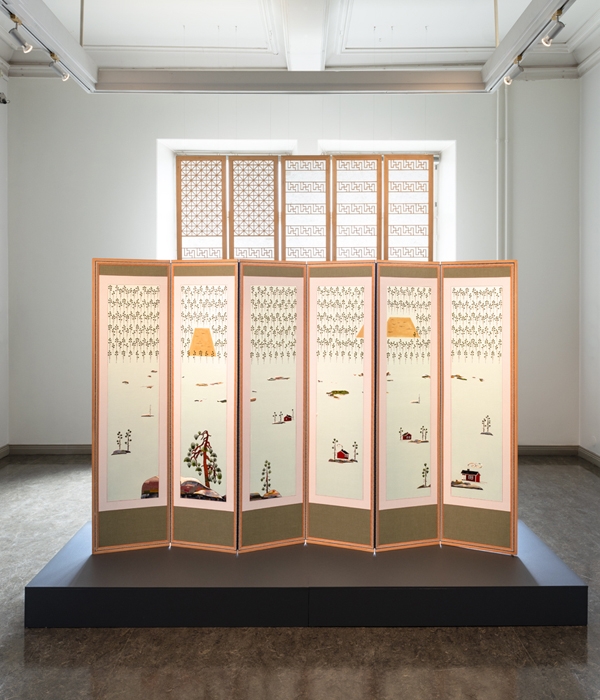Maisema Kolilta (för Lela) (Landscape from Koli_for Lela)
꼴리산수자수병풍(렐라 헌정작)
2023
silk thread on silk, six-panel folding screen
245 x 176cm
In this work we reimagine the landscape of Koli by using traditional Korean embroidery techniques. The central part of the piece follows the composition of Eero Järnefelt’s Maisema Kolilta, while also including typical Finnish cabins, islands, and pine trees as well as clear cutting sites.
Järnefelt’s Maisema Kolilta portrays what art historian Onni Oikkonen called the untouched and unspoiled “sacred beauty” and “monumentality of nature”. Järnefelt’s painting, along with the works of his contemporaries, turned the view from Ukko-Koli into what is commonly referred to as the Finnish national landscape. Apart from being a stunningly beautiful view this landscape was important for the national romantic movement and the nascent Finnish national identity - a struggle away from the East.
The work starts from the two following observations. Firstly, most of the authors of the National Romantic movement, Järnefelt included, were trained in France. The language that pictorially shaped the Finnish soul was, in a way, imported. Secondly, at the time of painting, the shores of lake Pielinen were already populated. The paintings of the wilderness simply left out the fields and the logging sites - as is so often the case when ideals are created.
The central motive in this piece is the Pine tree, and the different but equally central part it plays in both Korean and Finnish cultures. In Korean tradition, the pine tree represents longevity and virtue. Numerous poems have been written in honour of the tree, the Korean national anthem calls for its spirit and there is even an entire painting and embroidery tradition devoted to the pine. In Finland the pine is also very cherished, but for very different reasons. The Pine is a pivotal industrial product - one of the main fuels of the Finnish economy, subduing and shaping the entire scenery of the nation.
작품 <꼴리산수 자수병풍(렐라 헌정작)>은 한국 전통 자수를 통해 표현하는 핀란드 현대 산수화이다. 이 작품은 핀란드 풍경화의 대표적인 화가인 에로 야르네펠츠(Eero Järnefelt)가 그린 <꼴리 풍경화 Maisema Kolilta> (1928)를 모티브로 삼는다. 야르네펠츠의 회화는 당시 작품들과 함께, 핀란드 동쪽에 위치한 국립공원으로 유명한 욱꼬-꼴리(Ukko-koli)에서 바라본 풍경을 핀란드라는 국가를 대변하는 풍경으로 점철시켰다. 아름다운 경치 외에, 이 풍경은 민족주의적 낭만주의 운동과 ‘동쪽’ 즉 러시아의 끊임없는 침략과 문화경제적 잠식으로부터 벗어나기 위한 노력의 일환으로 초기 핀란드 민족 정체성 투쟁에 큰 역할을 했다. 하지만 이러한 역사적인 그림을 현대적 풍경으로 재해석하면서, 나나와펠릭스는 다음과 같은 두 가지 사실에 주목한다. 첫째, 민족주의적 낭만주의 운동을 이끈 저자들은 대부분 프랑스에서 교육을 받았고, 핀란드 영혼을 형상화한 언어는 ‘수입’되었다는 사실이다. 두 번째로, 피엘리넨 호수는 이미 사람이 살고 있었고, 황야에 대한 그림들에선 단순히 들판과 벌목 장소를 제외하고 묘사했다.
한국전통자수로 묘사될 풍경의 중앙부는 야르네펠츠의 <꼴리 풍경화> 구도를 따르며, 그 주변으로 핀란드의 전형적인 오두막집, 호수와 섬, 끊임없이 펼쳐지는 소나무 산림업 그리고 황폐한 벌목장이 나타난다. 이 자수 작업에서, 가장 중심적인 존재는 소나무인데, 한국과 핀란드의 두 가지 다른 관점에서 소나무를 해석한다. 한국 전통에서 소나무는 장수와 미덕을 상징하고, 소나무를 주제로 셀 수 없는 시와 그림이 만들어졌으며, 심지어 애국가에도 소나무가 등장한다. 반면 핀란드에서는 굉장히 다른 이유로 소나무의 가치가 이해되는데, 핀란드의 경제를 떠받드는 주요 사업인 소나무 산림업은 국립공원을 제외한 대부분의 핀란드 자연 풍경을 인위적인으로 제압하고 형성한다.
한국 전통자수에서만 사용되는 자릿수 외에 솔잎수, 이음수, 평수 등을 사용하여, 위에서 언급한 이상과 현실, 역사와 현재를 조합하여 핀란드의 현대적 풍경을 이질적으로 묘사한다.
